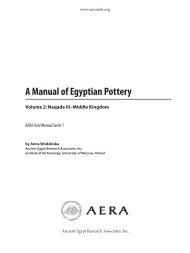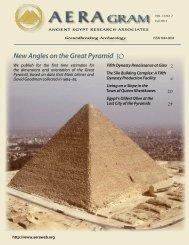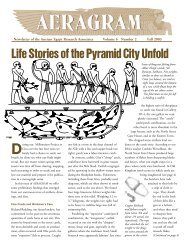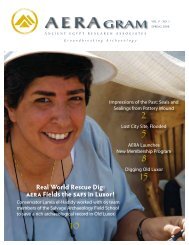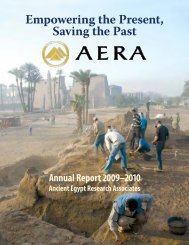The Khentkawes Town (KKT) - Ancient Egypt Research Associates
The Khentkawes Town (KKT) - Ancient Egypt Research Associates
The Khentkawes Town (KKT) - Ancient Egypt Research Associates
You also want an ePaper? Increase the reach of your titles
YUMPU automatically turns print PDFs into web optimized ePapers that Google loves.
www.aeraweb.org<br />
2008 <strong>KKT</strong> Human Osteology<br />
by Jessica Kaiser<br />
<strong>The</strong> first two burials were uncovered in the <strong>Khentkawes</strong><br />
<strong>Town</strong> (<strong>KKT</strong>) area during the 2005 season. However<br />
because the 2005 Field School was taking up much of the<br />
field resources at the time and that no actual excavation<br />
took place in <strong>KKT</strong> in 2005, they were left for a later season.<br />
In the 2008 excavation season, several more burial cuts<br />
were recognized in the <strong>KKT</strong>-F and <strong>KKT</strong>-AI areas, and nine<br />
burials (#452–460) were eventually excavated during<br />
March and April (Color Plates 1 and 2.1). <strong>The</strong> orientation<br />
of these burials was generally north-south with the heads<br />
located in the north end of the burials. Three of these were<br />
found oriented slightly off north; one oriented 10° west<br />
of magnetic north, a double burial oriented 20° east of<br />
magnetic north and one 15° east of magnetic north (Burials<br />
456, 457, and 458, respectively). Several of the burials<br />
had been truncated and were incomplete, but judging<br />
from the burials that were generally complete the bodies<br />
were positioned on their backs with their legs extended,<br />
thus indicating a late Old Kingdom or later burial. This<br />
corresponds to the burials cutting into the Old Kingdom<br />
features or walls. <strong>The</strong> remaining burials were incomplete<br />
with indications of having previously been excavated or<br />
truncated.<br />
Team Members<br />
Jessica Kaiser (University of California, Berkeley) led the<br />
2008 Osteological team, and team members included<br />
Johnny Karlsson (Stockholm Historical Museum), Afaf<br />
Wahba Abd-el-Salam (<strong>Egypt</strong>’s Supreme Council of<br />
Antiquities), Amanda Agnew (Ohio State University),<br />
Brianne Daniels (University of California, Berkeley),<br />
Ahmed Gabr (Supreme Council of Antiquities) and Sandra<br />
Koch (United States Federal Bureau of Investigation) 3 .<br />
Aims and Objectives<br />
In terms of the larger <strong>Ancient</strong> <strong>Egypt</strong> <strong>Research</strong> <strong>Associates</strong><br />
(AERA) project, the aims of the cemetery excavations on<br />
3. Kaiser Archaeological Services keeps the original<br />
documentation of excavation and analysis in Livermore,<br />
California. Copies of the documentation are kept in GPMP<br />
archives in both Giza and Boston.<br />
the plateau have always been to scientifically remove and<br />
record the human burials overlying the Old Kingdom<br />
archaeology that is the main focus of the AERA excavations.<br />
In terms of mortuary archaeology, the skeletal assessment<br />
aims to determine age, sex, and stature, as well as any<br />
pathological conditions from which the individuals may<br />
have suffered. In addition, the 2008 excavations gave the<br />
new additions to the team (Agnew, Daniels, and Koch)<br />
an opportunity to familiarize themselves with the AERA<br />
recording and excavation procedures, in preparation for<br />
future field school seasons when they themselves may be<br />
teachers. Information was also sought regarding the date<br />
of the <strong>KKT</strong> burials.<br />
Methodology<br />
As is general practice at AERA projects, bone specialists<br />
excavated all human remains. This is necessary due to<br />
the poor preservation of the bone. Without the expertise<br />
of a bone specialist, information would be lost. Further,<br />
and also according to AERA procedure, a large part of<br />
the skeletal analysis was carried out in situ, due to the<br />
fragmentary nature of the remains. In many cases,<br />
only bone stains remain, and measurements have to be<br />
taken before lifting the skeletal elements. <strong>The</strong> excavation<br />
procedure follows the guidelines set forth in the MoLAS<br />
manual (Museum of London 1994), while the skeletal<br />
recording system is site-specific, but largely adapted<br />
from Standards (Buikstra and Ubelaker 1994). All of the<br />
burials were photographed, elevations recorded by a total<br />
station system, and the skeletal remains were drawn with<br />
a computer mapping program, the resulting files to be<br />
imported into the overall plans of the site.<br />
All burials from <strong>KKT</strong> will be analyzed in detail in the<br />
laboratory, including assessing the preservation and completeness<br />
of each skeleton, as well as determining the age,<br />
sex, and stature of the individuals, and any pathological<br />
conditions.<br />
Osteological Analysis<br />
Osteological analysis centers on the determination of a<br />
demographic profile of the assemblage studied, based<br />
on the assessment of sex, age, and stature, as well as<br />
measurements and non-metric traits. This information is<br />
Giza Occasional Papers 4 49





